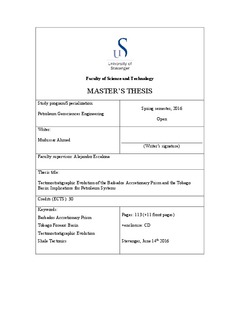| dc.contributor.advisor | Escalona, Alejandro | |
| dc.contributor.author | Ahmed, Mudussar | |
| dc.date.accessioned | 2016-10-12T14:36:21Z | |
| dc.date.available | 2016-10-12T14:36:21Z | |
| dc.date.issued | 2016-06-15 | |
| dc.identifier.uri | http://hdl.handle.net/11250/2414784 | |
| dc.description | Master's thesis in Petroleum geosciences engineering | nb_NO |
| dc.description.abstract | The Barbados accretionary prism is the only commercially hydrocarbon producing prism in the world. However, the offshore region is still underexplored and only one well has been drilled. Due to this there is poor understanding of reservoir and source rock distribution. In order to better the evolution of the prism and the petroleum system elements, a recently acquired regional 2D seismic data by Multi Client Geophysical (MCG) is interpreted.
Based on the tectonic setting, three main geological provinces are recognized: The Barbados accretionary prism; the Barbados ridge; and the Tobago forearc basin. The Barbados accretionary prism is the active part of the prism which is further subdivided into the northern extensional sub-province and the southern compressional sub-province. The Barbados ridge corresponds to an outer-arc high of forearc region. The ridge consists of a lower Paleocene to Oligocene older accretionary prism and an upper and younger prism cover of Plio-Pleistocene sediments. The Barbados ridge is backthrusted over the Tobago forearc basin which created an imbricate fan of thrust faults by deforming the forearc basin strata. Deformation in the study area is divided into five normal fault families and three thrust fault families based on the origin and mechanism of formation.
Five megasequences have been defined bounded by unconformities and/or correlative conformities. Interpretation of facies is based on seismic character and correlation with onshore Barbados. Megasequence-1 is of Late Cretaceous to Paleocene age and is deposited as growth strata in half grabens during the early stage of formation of the prism, and is draped by distal turbidites. Megasequence-2 is of Eocene to Oligocene age and is deposited as deep marine turbidites, sourced by the proto-Maracaibo delta in northwestern South America. Megasequence-3 is of Miocene age and is deposited in wide range of environments. Fan deltas to linked turbidites sourced from the Barbados ridge deposited in the Tobago Basin while mass transport complexes delivered from the South deposited in the Barbados accretionary prism. Megasequence-4 is of Pliocene age and consists of deep marine fine grained sediments. Megasequence-5 is of Pleistocene age and consists of ponded turbidites sourced from Orinoco delta deposited in mud withdrawal minibasins.
A four stage model is presented for the tectonostratigraphic evolution of the area. First stage is characterized by formation of the Barbados accretionary prism. It developed as a single univergent prism with structural style similar to the present day zone of initial accretion. In the second stage: the accretionary prism is divided into two parts. The older western part of the prism became the zone of stabilization due to uplift and intrusion of the Lesser Antilles Arc. Third stage is characterized by backthrusting of the accretionary prism over the forearc basin and sub-division of the prism into the present day four zones. Furthermore, a subducting seamount uplifted and emerged the Barbados Island. Fourth stage is characterized by renewed compression and associated shale tectonics in the zone of supra-complex basins. The deformation zone broaden and imbricate fan of thrust faults develop at the boundary between the Tobago forearc basin and the Barbados ridge. | nb_NO |
| dc.language.iso | eng | nb_NO |
| dc.publisher | University of Stavanger, Norway | nb_NO |
| dc.relation.ispartofseries | Masteroppgave/UIS-TN-IPT/2016; | |
| dc.rights | Navngivelse 3.0 Norge | * |
| dc.rights.uri | http://creativecommons.org/licenses/by/3.0/no/ | * |
| dc.subject | petroluemteknologi | nb_NO |
| dc.subject | petroleumsgeologi | nb_NO |
| dc.subject | petroleum geosciences engineering | nb_NO |
| dc.subject | tectonostratigraphic evolution | nb_NO |
| dc.title | Tectonostratigraphic Evolution of the Barbados Accretionary Prism and the Tobago Basin: Implications for Petroleum Systems | nb_NO |
| dc.type | Master thesis | nb_NO |
| dc.subject.nsi | VDP::Technology: 500::Rock and petroleum disciplines: 510::Geological engineering: 513 | nb_NO |

